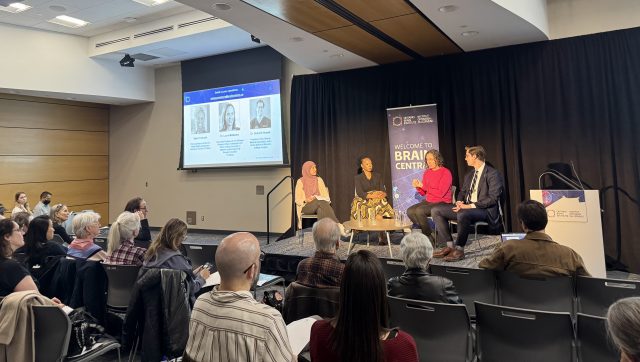By: Tamer Ismail, OBI Intern, Industry Relations
March 26th marks international Purple Day—a day to promote epilepsy awareness. This neurological disorder, characterized by erratic bursts of electrical activity, or seizures, affects many of us—about 80,000 people in Ontario alone which is why I think it’s critical that epilepsy awareness and support live up to the challenge.
It may be difficult to grasp the day-to-day difficulties that go hand-in-hand with epilepsy. The lack of seizure predictability places individuals under a great deal of anxiety and limits their range of activities and independence. As a result, people that live with epilepsy are at a greater risk of becoming depressed. A teacher of mine once told me that during a summer class, a student with epilepsy experienced a seizure in front of their classmates. Six students were so shocked as a result that they actually dropped out of the class. I believe this is a reflection of a gap in understanding that requires bridging. This is why the work of epilepsy-focused advocacy groups like Epilepsy Ontario and the many local agencies across the province is so important.
While advocacy groups are working hard to address the gaps in public understanding surrounding epilepsy, researchers, doctors, and industry are joining strengths to create better clinical outcomes for people affected by the disorder. From a medical standpoint, several unmet needs persist in the diagnosis and treatment of epilepsy. Current seizure-suppressing drugs only work in about 70% of the patients, leaving 30% with little or no adequate control over their seizures. Epilepsy surgery, arguably the only “cure” for seizures, is only suitable for individuals with seizures that can be localized to a specific area of the brain. Medical devices (e.g., the vagal nerve stimulator) can alleviate some seizure burden however, they are invasive and require follow-on surgeries for battery replacements. To further complicate matters, the unpredictability of seizure incidents makes it challenging to capture high-quality data for physicians to optimally treat people with epilepsy. As a result, doctors diagnose and treat epilepsy patients based on self-report diaries that may only capture a fraction of their total seizure activity. Therefore, it is very important to address drug-resistant epilepsy, which is the mandate of the Epilepsy Integrated Discovery Program (EpLink).
I recently attended an EpLink workshop that aimed to bring together researchers, clinicians, patients and their advocates, and entrepreneurs that are working on epilepsy challenges. I was amazed by the diversity of approaches and the passion that was exhibited by the attendees. I got the chance to speak with Professor Roman Genov and learn about his research group’s integration of early EEG-based seizure detection that uses electrical stimulation to disrupt the mounting electrical activity which can lead to seizures. Another research project that caught my eye was EpLink’s Genetics Program which is sequencing the DNA of 320 individuals with epilepsy in order to examine the underlying genes that may cause epilepsy. And since inspiration can be serendipitous, Professor Michael Poulter’s laboratory has identified a Himalayan Mountains-based flower root extract that has been used by the local population for centuries to treat seizures.
Such integrated efforts by EpLink have given rise to multiple promising Ontario-based innovations that are currently undergoing testing and development. One such technology is Ketogen Pharma’s acetone analogue drugs that offer the “ketogenic diet in a pill”. This innovation has shown encouraging results in preclinical tests and has the potential to eliminate the need for strict dietary restrictions in some individuals with epilepsy. Another Ontario-based up-and-comer is the Avertus Seizure Monitoring At the Right Time (SMART) Headset that enables the portable EEG recording of electrical brain activity of people with epilepsy from the comfort of their homes. Based on the rich seizure data obtained from each patient, this device allows for better epilepsy characterization and a more personalized approach to making decisions about treatment.
Together, the dedication of epilepsy researchers, clinicians and entrepreneurs, coupled with state-of-the-art borderless discovery efforts, carry the hope for a brighter future for those affected by epilepsy, where anxiety, stigma and dependence are replaced with control, integration and autonomy.



